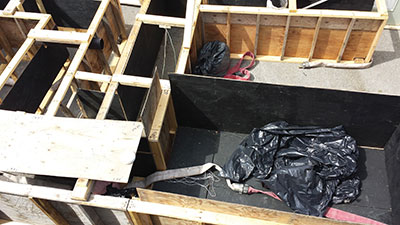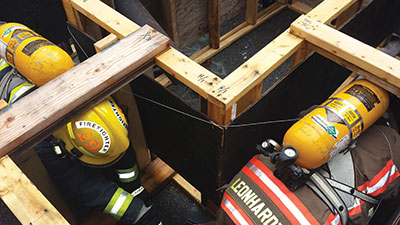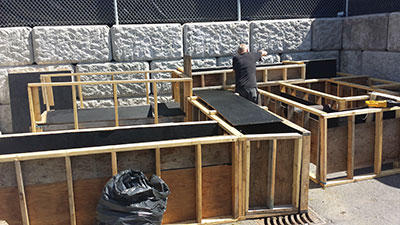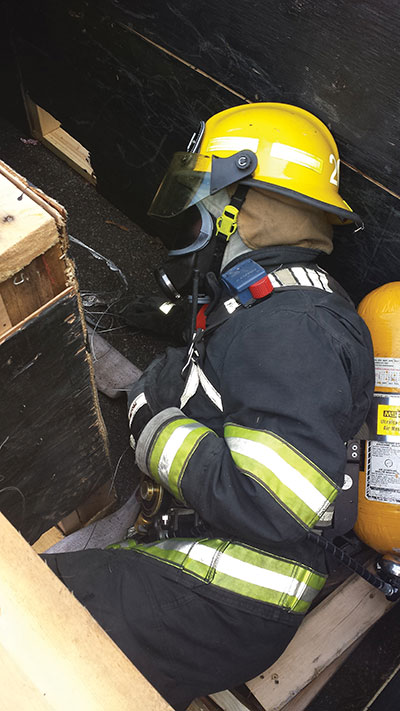
Features
Structural
Training
Trainer’s Corner: June 2014
As I wrote this, our Saving Our Own Hands-On Training (SOO HOT) team was preparing for the annual volunteer firefighter training seminar, hosted this year by Oliver Fire & Rescue in British Columbia from May 2 to 4.
June 2, 2014
By Ed Brouwer
As I wrote this, our Saving Our Own Hands-On Training (SOO HOT) team was preparing for the annual volunteer firefighter training seminar, hosted this year by Oliver Fire & Rescue in British Columbia from May 2 to 4. We unveiled our new firefighter survival maze, called Firefighter’s Ghost – which is more of an evaluation prop than an instructional one. This new maze is designed in honour of our fallen brothers and sisters. It is our hope that we can learn from their sacrifices.
 |
|
| An aerial view of the the Firefighter’s Ghost maze developed by Canwest Fire to teach firefighters when to call a mayday; just five of 100 firefighters stopped before they fell through the trap-door floor. photos by ed brouwer |
This year marks the tenth anniversary of the line-of-duty death of Clearwater, B.C., firefighter Chad Shapansky, who died in a structure fire on March 29, 2004. At Shapansky’s funeral, I made a conscious decision to do all I can to promote a standard mayday protocol in Canada. Unfortunately, 10 years later, we in the fire service still spend more time training firefighters to tie knots than to perform self-rescue.
Whether full time, volunteer or paid on-call, fire personnel routinely conduct operations that put them in dangerous situations. Fire fighting by its very nature places firefighters in close proximity to fire or in areas that have suffered structural damage due to the effects of fire. Falling through burned-out floors or becoming entangled in the debris of a ceiling collapse are real and constant threats.
 |
|
| Two firefighters make their way through the maze; note the wire caught on the lead firefighter’s pack. Neither firefighter noticed this entanglement until the lead firefighter could move no further ahead; neither had pliers to cut the wire.
|
Firefighters must practise self-rescue techniques over and over again in order for these skills to come to mind in a crisis situation. Repetitive training may be the only way to break the panic mode that robs firefighters of their ability to rationally think their way out of trouble. The more survival tools we give our firefighters, the greater their chances of going home after the call. The greatest survival tool, in my humble opinion, is to give clear instruction on calling a mayday.
The following is a basic outline and description of Canwest’s SOO HOT survivor maze. I will be glad to email you a material list and layout plan.
Firefighters wearing complete PPE including SCBA will be paired up into teams. Before teams enter the maze each firefighter will be given a single die to roll. The total of their rolls will set the time limit (one minute per point) before their low air alarm will sound. We will sound an alarm to signify the low air alert.
 |
|
| Ed Brouwer puts the finishing touches on the Firefighter’s Ghost maze used for mayday training in an exercise with 40 departments; one of 100 participants correctly called a mayday.
|
The firefighters are given radio. The instructor places a foam sheet in their BA masks, blocking 80 to 90 per cent of their vision. The firefighters are then led to the maze entrance, a 0.6-metre (two-foot) wide by one metre (three-foot) high tunnel that we constructed out of 2x4s and plywood.
At the entrance, the firefighters find a hoseline that is charged with air to simulate water. We made two end caps for the fire hose with an air valve mounted on one end. The firefighters are told to follow the hose to safety. We do not provide any other instructions; we are there only as observers. The firefighters’ safe completion of this task rests squarely on the training they have received from their own departments.
I have wondered just how much instruction we can adequately provide to 20 firefighters in less than an hour during these training weekends, so we decided to evaluate what the firefighters had learned from their own department’s training.
Our instructors, armed with clipboards and evaluation sheets, follow the teams and mark a pass or fail in the appropriate spaces.
The entire maze is painted flat black. An alarm bell sounds when a firefighter’s time is up, simulating the low air alarm on the SCBA.
 |
|
| A firefighter radios the incident commander before going further into the maze; a good job!
|
As the firefighters follow the hose, they encounter fire-ground hazards such as entanglement debris, narrow openings, and blocked passages. We even designed the maze so that the hose the firefighters follow actually disappears in several places. Holes cut in certain side panels allow the instructor to take the hose out of the tunnel and then re-insert it further along. This simulates a firefighter losing contact with the hose. We insert several 0.6-metre (two-foot) by 0.6-metre (two-foot) panels, forcing firefighters to react to blocked passages. No obstacles in the maze require the removal of the firefighter’s SCBA – in fact, firefighters shouldn’t even have to low profile their SCBAs to navigate the maze. However, the instructor will not interfere should the firefighter choose to do either of those time-consuming and potententialy dangerous procedures.
Near the end of the maze we put in a small set of steps (2) leading into a 1.2-metre (four-foot) wide by 2.4-metre (eight-foot) long box. At this point, the 1.2-metre (four-foot) wide floor piece, on which the firefighter is kneeling, has been split down the middle and hinged on both sides. Once the lead firefighter reaches the middle of the suspended floor, the instructor pulls the pin, causing the floor to collapse in the middle. The firefighter may roll, slide or fall off the floor panel. This simulates falling through the floor. It is interesting to see how firefighters react to this hazard.
This concludes the evaluation. After a few moments of observation, the firefighters are helped out of the maze and their SCBA is removed. All teams are then debriefed and are given a copy of their evaluation reports along with a Congratulations or a Deepest Sympathy card. Perhaps the cards are a bit dramatic, but the importance of calling a mayday must sink in.
The main objective of our survival maze is to determine if a firefighter will call a mayday. There are nine yes-or-no points that are evaluated.
- Did the firefighter note the air supply level during the drill?
- Did the firefighter radio incident command (IC) to inform the IC that he or she lost the hose?
- Did the firefighter radio IC to inform the IC when he or she found the hose?
- Did the firefighter radio IC to inform the IC that the low-air alarm had activated?
- Did the firefighter radio a mayday after the low-air alarm activated if he or she was not able to exit within 60 seconds?
- Did the firefighter activate his or her PASS alarm upon hearing the low-air alarm if he or she was not able to exit within 60 seconds?
- Did the firefighter radio a mayday when he or she fell through the floor?
- Did the firefighter activate his or her PASS alarm at any time?
- Did the firefighter follow the hoseline in the right direction?
As instructors, we are harsh in our marking, but we have decided that any more than three points marked “No” indicates that the firefighter does not understand the basic need to call a mayday.
Our hope is these firefighters will take their evaluations seriously enough to either thank their training officers for a job well done or demand some clarification as to their department’s mayday training program.
We have not devoted enough attention to rescuing ourselves, and too often the results are tragic. It is only when both instructors and firefighters have these commitments in common that we will be successful in the Canadian fire service. We must train our firefighters as if their lives depend on our training. Let no firefighter’s ghost say his training let him down.
An update from Oliver B.C.: The maze was a great success, but it was bittersweet for our instructors. The stats were very disappointing and it was obvious that we in the fire service are missing the mark regarding mayday training. Only one firefighter out of 100 scored a perfect – and that was Eric Phibbs of Boston Bar. There were no other succesful completions. Just two teams noted their air supply, only five teams informed the IC they had lost the hose, and only three teams notified the IC they had found the hose. Ten teams notified the IC when their low air alarms were activated, and just two teams called a mayday when they were not able to exit the building within 60 seconds after their low air-alarms activated.
We really appreciate the opportunity afforded to us by Oliver Fire Rescue to present Firefighter’s Ghost to more than 40 British Columbia fire departments. We hope the wake-up call these departments received will lead to a greater awareness as to the need for mayday training.
Ed Brouwer is the chief instructor for Canwest Fire in Osoyoos, B.C., and Greenwood Fire and Rescue. The 25-year veteran of the fire service is also a fire warden with the B.C. Ministry of Forests, a wildland urban interface fire-suppression instructor/evaluator and an ordained disaster-response chaplain. Contact Ed at ebrouwer@canwestfire.org
Print this page